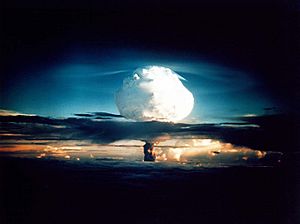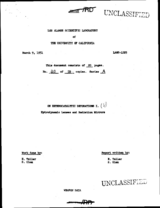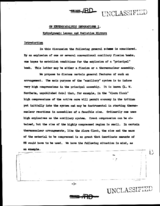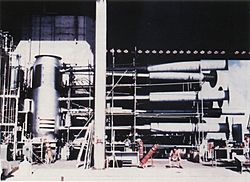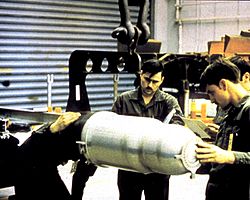History of the Teller–Ulam design facts for kids
This article tells the story of the history and origins of the Teller–Ulam design. This is the special technical idea behind modern thermonuclear weapons, also known as hydrogen bombs. The exact details of this design are military secrets known only to a few major countries. However, it is believed that almost all modern nuclear weapons use this design.
Contents
History of the Hydrogen Bomb
Early Ideas: Teller's "Super"
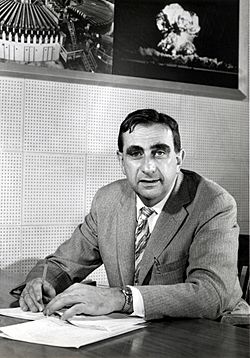
The idea of using energy from a fission bomb to start a fusion reaction first came from Italian physicist Enrico Fermi. He suggested it to his friend Edward Teller in 1941. This was during the Manhattan Project, the secret World War II effort by the United States and United Kingdom to build the first nuclear weapons.
Teller soon joined a meeting led by J. Robert Oppenheimer at the University of California, Berkeley. Here, Teller guided discussions towards his idea for a "Super" bomb. This bomb would be much more powerful than the fission bomb they were still trying to develop. Teller thought building the fission bomb was just an engineering task. He found the "Super" bomb a much more interesting challenge for scientists.

During the war, the main focus was on creating fission weapons first. But Teller kept working on his "Super" bomb. He even sometimes ignored his assigned work for the fission bomb at the secret Los Alamos National Laboratory. (Some of the work Teller didn't do was given to Klaus Fuchs, who was later found to be a spy for the Soviet Union.)
The "Super" bomb proved difficult to design. The calculations were very hard, and there was no way to test the ideas on a small scale. In contrast, fission properties could be studied more easily with cyclotrons and new nuclear reactors.
After the atomic bombings of Japan, scientists at Los Alamos were shocked by how destructive the weapons were. Many scientists did not want to create a weapon thousands of times more powerful. They worried about the technical challenges and the moral issues. Such a powerful weapon, they argued, could only be used against many people, leading to mass destruction.
Many scientists, like Teller's friend Hans Bethe, urged the United States not to build such weapons. They hoped the US would set an example for the Soviet Union. But supporters like Teller and Berkeley physicists Ernest Lawrence and Luis Alvarez argued that such a weapon was bound to be made. They felt it would be wrong to deny this protection to the US, especially if the Soviet Union built one. Other scientists, like Oppenheimer, thought it was better to build many smaller atomic weapons instead of a few huge "Supers."
Work at Los Alamos slowed down a lot after the war. Many scientists left to go back to their universities. In 1946, a meeting at Los Alamos looked into building a Super bomb. They decided it was possible, but some disagreed.
When the Soviet Union exploded its own atomic bomb in August 1949, it surprised Western experts. For months, there was a big debate in the US government, military, and science groups. They argued whether to build the much more powerful Super bomb. On January 31, 1950, US President Harry S. Truman ordered a program to develop a hydrogen bomb.
Many scientists returned to Los Alamos to work on the "Super" program. But the first ideas still seemed impossible. In the "classical Super" design, they thought only the heat from the fission bomb would ignite the fusion material. This turned out to be impossible. For a while, many scientists thought (and hoped) the weapon could not be built.
Breakthroughs by Ulam and Teller
The exact story of the Teller–Ulam breakthrough is not fully known. This is partly because different people remember it differently. Also, many documents that could show the truth are still secret. Earlier ideas for the "Super" bomb had the fusion fuel either around the fission "trigger" or inside it. Scientists hoped that being close to the fission explosion would ignite the fusion fuel with intense heat.
In 1951, after many years of trying without success, Polish mathematician Stanislaw Ulam had a breakthrough idea. Teller then took this idea and developed it into the first working design for a very powerful hydrogen bomb. This idea, now called "staged implosion," was first described in a secret scientific paper. It was titled On Heterocatalytic Detonations I. Hydrodynamic Lenses and Radiation Mirrors by Teller and Ulam on March 9, 1951.
How much Ulam and Teller each contributed to what became known as the "Teller–Ulam design" is not fully known to the public. Teller often took much of the credit. In a 1999 interview, Teller said, "I contributed; Ulam did not." He said Ulam was unhappy with the old approach and came to him with part of an idea Teller already had.
Other scientists have different views. Hans Bethe said in 1952 that Teller found a "completely new way" to make thermonuclear reactions. He called it a "stroke of genius" in 1954. But other scientists, like J. Carson Mark, said Teller would not have succeeded without Ulam's idea. Nuclear weapon designer Ted Taylor gave Ulam credit for the basic ideas of staging and compression. He credited Teller for realizing that radiation, not just pressure, was key.
Teller became known as the "father of the hydrogen bomb" in the news. Many of his colleagues were annoyed that he seemed to take all the credit. So, Teller wrote an article called "The Work of Many People" in 1955. He said he was not alone in developing the weapon. (Later, in his memoirs, he said this was a "white lie" and implied he should get full credit.) Hans Bethe joked, "Ulam is the father, because he provided the seed, and Teller is the mother, because he remained with the child. As for me, I guess I am the midwife."
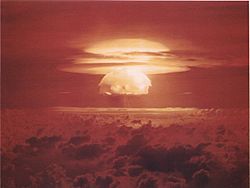
The Teller–Ulam breakthrough, whose details are still secret, was likely separating the fission and fusion parts of the weapon. It used the radiation from the fission bomb to first squeeze the fusion fuel before igniting it. Some sources say Ulam first suggested squeezing the secondary (fusion part) with shock waves from the primary (fission part). Then Teller realized that radiation from the primary could do the job (this is called "radiation implosion"). However, squeezing alone would not have been enough. The other crucial idea, staging the bomb by separating the primary and secondary, seems to have come only from Ulam.
The design was so clever that many scientists who thought it was impossible suddenly believed it was unavoidable. Even Oppenheimer, who was against the project, called the idea "technically sweet." The "George" test in Operation Greenhouse in 1951 tested the basic idea on a very small scale. This made scientists almost certain the concept would work.
On November 1, 1952, the Teller–Ulam design was tested in the "Ivy Mike" shot. This happened on an island in the Enewetak atoll. It had a yield of 10.4 megatons, which is over 450 times more powerful than the bomb dropped on Nagasaki. The device, called the Sausage, used a very large fission bomb as a "trigger." It used liquid deuterium as its fusion fuel, kept liquid by 20 tons of cooling equipment. The whole device weighed about 80 tons. The US soon announced that it had exploded a megaton-range hydrogen bomb.
The "Ivy Mike" device needed a huge cooling plant to keep its fuel liquid. This made it too heavy and complex to be practical for military use. The first deployable Teller–Ulam weapon in the US was developed in 1954. It replaced the liquid deuterium fuel with a dry fuel called lithium deuteride. This was tested in the "Castle Bravo" shot, with the device nicknamed the Shrimp.
The dry lithium mixture worked much better than expected. The "Castle Bravo" device had a yield two and a half times greater than predicted, at 15 megatons. It was the most powerful bomb ever exploded by the United States. Because much of its power came from the final fission stage of its uranium-238 tamper, it created a lot of nuclear fallout. This caused one of the worst nuclear accidents in US history. Unexpected weather patterns blew the fallout over populated areas and onto Japanese fishermen.
After building very large hydrogen bombs, the United States focused on making smaller Teller–Ulam weapons. These could fit on Intercontinental Ballistic Missiles (ICBMs) and Submarine Launched Ballistic Missiles. By the mid-1970s, they had created versions of the Teller–Ulam design small enough for MIRVed missiles, which carry multiple warheads.
Soviet Research
In the Soviet Union, scientists working on their own hydrogen bomb project also faced problems building a megaton-range fusion weapon. Klaus Fuchs had only been at Los Alamos very early in the hydrogen bomb design process. So, his spy information was not very useful. Soviet physicists had to develop their weapon on their own.
The first Soviet fusion design, called the Sloika, was developed by Andrei Sakharov and Vitaly Ginzburg in 1949. It was named after a Russian layered pastry. This design was not the Teller–Ulam type. Instead, it used alternating layers of fission material and lithium deuteride fusion fuel mixed with tritium. (This was later called Sakharov's "First Idea.")
While it did achieve nuclear fusion, it could not be scaled up like a "staged" weapon. Their first "hydrogen bomb" test, "Joe 4" in 1953, is now seen more as a hybrid fission/fusion device. It was more like a large boosted fission weapon than a true Teller–Ulam weapon. It had a yield of 400 kilotons, with only 15-20% from fusion. However, the Sloika device could actually be delivered to a military target, unlike the "Ivy Mike" device. Teller had suggested a similar design in 1946, called the "Alarm Clock," but it was never built or tested.
Attempts to use the Sloika design to reach megaton-range results failed in the Soviet Union, just as calculations showed in the US. But its value as a practical weapon, being 20 times more powerful than their first fission bomb, was important. Soviet physicists thought the design could at best yield one megaton.
After the US tested "Ivy Mike" in 1952, proving a multimegaton bomb was possible, the Soviets looked for a new design. They also kept trying to improve the Sloika ("First Idea"). Sakharov's "Second Idea" was a proposal by Ginzburg in 1948 to use lithium deuteride. This material would produce tritium when hit by neutrons.
In late 1953, physicist Viktor Davidenko made the first breakthrough: keeping the primary and secondary parts of the bombs separate ("staging"). The next breakthrough came from Sakharov and Yakov Zeldovich in 1954. They discovered how to use the X-rays from the fission bomb to squeeze the secondary before fusion ("radiation implosion"). Sakharov's "Third Idea," which was the Teller–Ulam design in the Soviet Union, was tested in the "RDS-37" shot in November 1955. It had a yield of 1.6 megatons.
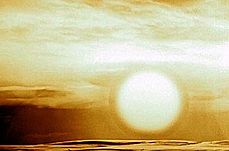
Sakharov wrote in his memoirs that he and Davidenko had fallout dust from the "Mike" test. They hoped to analyze it for information. But a chemist at Arzamas-16 (the Soviet weapons lab) accidentally poured the sample down the drain. Only in late 1952 did the Soviet Union set up a system to monitor fallout data.
Still, Sakharov's memoirs say that the yield from one of the American tests, which caused an international incident with Japan, told him the US design was much better. He realized the US must have exploded a separate fission bomb and used its energy to squeeze the lithium deuteride. He then figured out how to focus the X-rays to do this.
The Soviets showed the power of the "staging" idea in October 1961. They exploded the huge Tsar Bomba, a 50-megaton hydrogen bomb. Almost 97% of its energy came from fusion, not fission. Its uranium tamper was replaced with lead just before firing to reduce nuclear fallout. If it had been fired in its "full" form, it would have yielded about 100 megatons. The weapon could technically be delivered (it was tested by dropping it from a special bomber). But it was too big to be practical for military use. It was developed and tested mainly to show Soviet strength. It is the largest nuclear weapon ever developed and tested by any country.
Other Countries with the Teller–Ulam Design
United Kingdom
Less is known about how other countries developed the Teller–Ulam design. The United Kingdom had trouble at first. Their "Grapple I" test in May 1957 did not ignite as planned. But their second attempt, "Grapple X" in November 1957, succeeded with a 1.8 megaton yield.
The British seemed to develop the design on their own. However, they were allowed to see some US fallout data, which might have helped. After successfully exploding a megaton-range device and understanding the Teller–Ulam "secret," the United States agreed to share some of its nuclear designs with the United Kingdom. This led to the 1958 US-UK Mutual Defence Agreement.
China
The People's Republic of China exploded its first device using a Teller–Ulam design in June 1967. This was called "Test No. 6." It happened only 32 months after they exploded their first fission weapon. This is the shortest time known for a country to go from fission to fusion. The test had a yield of 3.3 megatons. Not much is known about China's thermonuclear program. Yu Min led the development of the bomb.
France
Very little is known about France's development of the Teller–Ulam design. They exploded a 2.6 megaton device in the "Canopus" test in August 1968.
India
On May 11, 1998, India announced it had exploded a hydrogen bomb in its Operation Shakti tests ("Shakti I"). Some experts outside India, using seismic readings, doubted this. They pointed to the test's low yield, which they said was about 30 kilotons. India had announced 45 kilotons.
However, some non-Indian experts agreed with India. Dr. Harold M. Agnew, former director of the Los Alamos National Laboratory, believed India's claim of detonating a staged thermonuclear bomb. British seismologist Roger Clarke said seismic data suggested a combined yield of up to 60 kilotons, which matched India's announced total yield of 56 kilotons. Professor Jack Evernden, a US seismologist, always said that to correctly estimate yields, one must consider geological differences between test sites. His estimates for India's tests matched India's.
Indian scientists said some international estimates of their nuclear tests were not scientific. India says its test yields were kept low on purpose to avoid harm to civilians. They also say they can build staged thermonuclear weapons of different yields, up to about 200 kilotons, based on those tests. Another reason for low yields was that too much radioactivity from yields over 45 kilotons might not have been contained.
Even low-yield tests can provide useful information for thermonuclear capability. They can show how the primaries (fission parts) behave without fully igniting the secondaries (fusion parts).
North Korea
North Korea claimed to have tested a small thermonuclear bomb on January 6, 2016. North Korea's first three nuclear tests (2006, 2009, and 2013) had low yields. They did not seem to be thermonuclear weapon designs. In 2013, the South Korean Defense Ministry thought North Korea might be trying to develop a "hydrogen bomb."
In January 2016, North Korea claimed a successful hydrogen bomb test. But only a magnitude 5.1 seismic event was detected, similar to their 2013 test of a 6–9 kiloton atomic bomb. These seismic readings made scientists worldwide doubt North Korea's claim. They suggested it was not a fusion nuclear test. On September 9, 2016, North Korea conducted its fifth nuclear test, yielding between 10 and 30 kilotons.
On September 3, 2017, North Korea conducted a sixth nuclear test. This happened just hours after photos of North Korean leader Kim Jong-un inspecting a device that looked like a thermonuclear weapon warhead were released. Initial estimates were between 70 and 160 kilotons. A week later, they were raised to 250 to over 300 kilotons. Jane's Information Group estimated the bomb might weigh between 250 and 360 kilograms (about 550–790 lbs.), based on looking at propaganda pictures.
Public Knowledge of the Design
For many years, the Teller–Ulam design was considered one of the top nuclear secrets. Even today, official government papers do not discuss it in detail. The United States Department of Energy (DOE) has a policy not to confirm when secret information is leaked. This is because confirming it would mean the leaked information is true.
Aside from pictures of the bomb's outer casing (never the "physics package" itself), most public information about the design comes from a few short statements and the work of a few individual researchers.
Early Public Information
The general ideas of the "classical Super" design were known even before thermonuclear weapons were first tested. After President Truman ordered the hydrogen bomb program in 1950, Boston Daily Globe published a drawing of a possible hydrogen bomb. It showed an atomic bomb as a "trigger" to create enough heat for the H-bomb's "thermonuclear fusion" process.
The fact that a large part of a thermonuclear bomb's power comes from the fission of a uranium-238 tamper (the fission-fusion-fission principle) became known when the Castle Bravo test produced a much higher yield than expected and created a lot of nuclear fallout.
Government Statements
In 1972, the DOE made a statement public: "In thermonuclear (TN) weapons, a fission 'primary' is used to trigger a TN reaction in thermonuclear fuel called a 'secondary'." In 1979, they added: "Radiation from a fission explosive can be contained and used to transfer energy to compress and ignite a physically separate component containing thermonuclear fuel." They added that "Any elaboration of this statement will be classified."
In 1991, another statement was made public: "Fissile and/or fissionable materials are present in some secondaries, material unidentified, location unspecified, use unspecified, and weapons undesignated." In 1998, the DOE declassified the statement that "Materials may be present in channels and the term 'channel filler,' with no elaboration." This might refer to the polystyrene foam (or a similar substance).
It is debated whether these statements confirm the public models of the design. Official US government releases about nuclear weapons have often been unclear on purpose. Other information, like the types of fuel used in early weapons, has been made public, but exact technical details have not.
The Progressive Case
United States v. The Progressive Most of what we know publicly about the Teller–Ulam design came out after the DOE tried to stop a magazine article in 1979. The article was by anti-weapons activist Howard Morland. In 1978, Morland decided that finding and sharing the "last remaining secret" would draw attention to the arms race. He hoped it would make citizens feel able to question official statements about nuclear weapons and secrecy.
Morland gathered most of his ideas about how the weapon worked from easily available sources. The drawings that helped him most came from the Encyclopedia Americana. Morland also talked to many former Los Alamos scientists, sometimes informally. He tried to get information from them by asking questions like, "Do they still use sparkplugs?" even if he didn't know what that term meant.
Morland eventually concluded that the "secret" was that the primary and secondary parts were kept separate. He thought that radiation pressure from the primary squeezed the secondary before igniting it. When an early draft of his article, meant for The Progressive magazine, was sent to the DOE, the DOE asked that it not be published. They got a temporary court order to stop its publication.
In court, the DOE argued that Morland's information was likely from secret sources. They also said that even if it wasn't from secret sources, it was still "secret" under the "born secret" rule of the 1954 Atomic Energy Act. Finally, they argued it was dangerous and would encourage nuclear proliferation (more countries getting nuclear weapons). Morland and his lawyers disagreed. But the judge granted the order, thinking it was safer. Morland and his team appealed the decision.
Due to other complex events, the DOE's case weakened. It became clear that some of the "secret" information they claimed had been published in a children's encyclopedia years earlier. After another person, Chuck Hansen, had his own ideas about the "secret" published in a newspaper, the DOE dropped its lawsuit. They said the case was no longer relevant. This allowed The Progressive magazine to publish Morland's article in November 1979.
However, Morland had changed his mind by then. He now thought that a foam material (polystyrene) rather than radiation pressure was used to squeeze the secondary. He also thought the secondary had a "sparkplug" of fission material inside. He published these changes as a short correction in The Progressive a month later. In 1981, Morland wrote a book, The secret that exploded, about his experience. He described how he came to his conclusions about the "secret."
The DOE tried to stop Morland's work, which was rare for them. This suggests that his information was at least partly correct. But how much information is missing or wrong is not known for sure. The fact that many countries had trouble developing the Teller–Ulam design (even when they understood the idea, like the United Kingdom) suggests that simply knowing the information is not enough to build thermonuclear weapons. Still, the ideas Morland put forward in 1979 have been the basis for all current guesses about the Teller–Ulam design.
See also
 In Spanish: Proceso Teller-Ulam para niños
In Spanish: Proceso Teller-Ulam para niños


